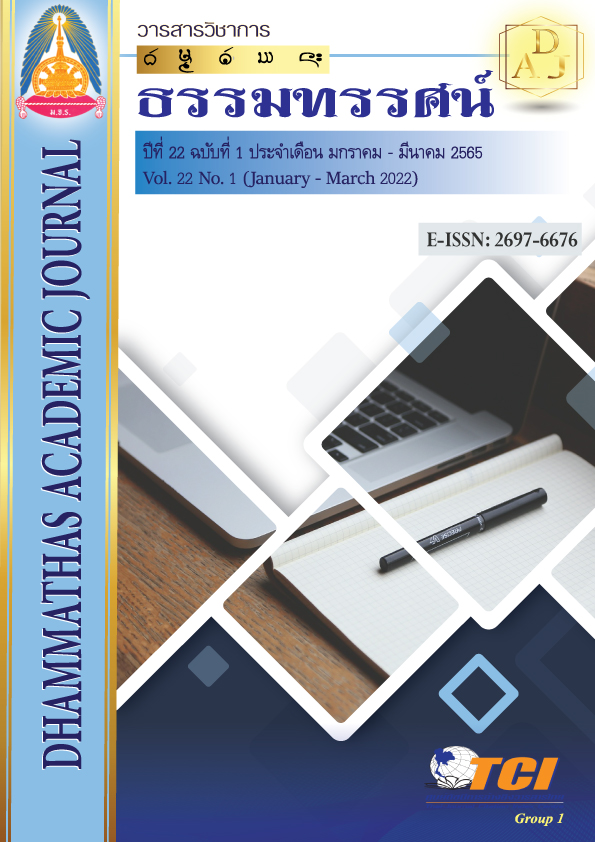An Analytical Study of applying Buddhist Principle for Reconciliation of Mediators in Khon Kaen Provincial Court
Main Article Content
Abstract
This research has the objectives to study: 1) Buddhist principles in reconciliation in Theravada Buddhism, 2) the methods of reconciliation of reconciliatory in Khon Kaen provincial court, and 3) the application of Buddhist principles in reconciliation of reconciliatory in Khon Kaen provincial court. This is the qualitative research, and the researcher collected and studied form Tipitaka, commentary, texts, books, and related documents about reconciliation. The researcher interviewed reconciliatory, parties, layers in reconciliation center in Khon kaen provincial court including the Buddhist experts in reconciliation and analyzed the data by inductive methodology.
The results revealed that:
1. Buddhist principles in reconciliation in Theravada Buddhism emphasizes on the root cause of the conflict to find peace and resolve it together.
2. The reconciliation of reconciliatory in Khon Kaen provincial court does mainly focus on the root cause and how to manage to solve with dispute.
3. The Court meditator have applied the Buddhist principles into the reconciliation process. To effectively resolve the dispute, there are 4 steps; 1) Dispute analysis, 2) Gaining trust, 3) Creating peace, and 4) Creating harmony. Based on Buddhist Principle for Mediation, meditators should look for the root of clause of the conflicts of disputes and then, solve that. The way to use Buddhist Principle could help to alleviate and would lead disputes to have the right thought to mutually solve their problem together.
Article Details

This work is licensed under a Creative Commons Attribution-NonCommercial-NoDerivatives 4.0 International License.
เพื่อให้เป็นไปตามกฎหมายลิขสิทธิ์ ผู้นิพนธ์ทุกท่านต้องลงลายมือชื่อในแบบฟอร์มใบมอบลิขสิทธิ์บทความ ให้แก่วารสารฯ พร้อมกับบทความต้นฉบับที่ได้แก้ไขครั้งสุดท้าย นอกจากนี้ ผู้นิพนธ์ทุกท่านต้องยืนยันว่าบทความ ต้นฉบับที่ส่งมาตีพิมพ์นั้น ได้ส่งมาตีพิมพ์เฉพาะในวารสาร วิชาการธรรม ทรรศน์ เพียงแห่งเดียวเท่านั้น หากมีการใช้ ภาพหรือตารางของผู้นิพนธ์อื่นที่ปรากฏในสิ่งตีพิมพ์อื่นมาแล้ว ผู้นิพนธ์ต้องขออนุญาตเจ้าของลิขสิทธิ์ก่อน พร้อมทั้ง แสดงหนังสือที่ได้รับการยินยอมต่อบรรณาธิการ ก่อนที่บทความจะได้รับการตีพิมพ์References
ข้อกำหนดประธานศาลฎีกา ว่าด้วยการไกล่เกลี่ยก่อนฟ้อง พ.ศ. 2563. (2563, 7 พฤศจิกายน). ราชกิจจานุเบกษา. เล่ม 137 ตอนที่ 93 ก, หน้า 1-3.
จอห์น แมคคอนแนล. (2549). ศาสตร์และศิลป์แห่งการระงับความขัดแย้ง. พระไพศาล วิสาโล แปล. กรุงเทพฯ: มูลนิธิเด็ก.
โชติช่วง ทัพวงศ์. (2550). การไกล่เกลี่ยข้อพิพาทในศาลในการจัดการความขัดแย้งในการไกล่เกลี่ยข้อพิพาท ความรู้เบื้องต้นเกี่ยวกับการระงับข้อพิพาท. กรุงเทพฯ: ธนาเพรส.
ปรัชญา อยู่ประเสริฐ. (2550). ขั้นตอนกระบวนการไกล่เกลี่ยข้อพิพาทในเทคนิคจิตวิทยาและการสื่อสารสำหรับการไกล่เกลี่ยข้อพิพาท. กรุงเทพฯ: ธนาเพรส.
พระธรรมปิฏก (ป.อ. ปยุตฺโต). (2546). สลายความขัดแย้ง. กรุงเทพฯ: สหธรรมิก.
พระไพศาล วิสาโล. (2552). การไกล่เกลี่ยแบบพุทธ. เข้าถึงได้จาก https://www.visalo.org/article/P_karnKlaiKlear.htm
พระราชบัญญัติการไกล่เกลี่ยข้อพิพาท พ.ศ. 2562. (2562, 22 พฤษภาคม). ราชกิจจานุเบกษา. เล่ม 136 ตอนที่ 67 ก, หน้า 1-21.
พระราชบัญญัติแก้ไขเพิ่มเติมประมวลกฎหมายวิธีพิจารณาความแพ่ง (ฉบับที่ 32) พ.ศ. 2563. (2563, 8 กันยายน). ราชกิจจานุเบกษา. เล่ม 137 ตอนที่ 71 ก, หน้า 1-3.
พระอธิพันธ์ อภิปุณฺโณ (จันทรปรีชายุทธ), พระมหาหรรษา ธมฺมหาโส และพระมหาดวงเด่น ฐิตญาโณ. (2560). ศึกษาเปรียบเทียบรูปแบบการไกล่เกลี่ยเชิงพุทธกับระบบ เจ้าโคตร. วารสารสันติศึกษาปริทรรศน์, 5(ฉบับพิเศษ), 227-237.
มหาจุฬาลงกรณราชวิทยาลัย. (2539). พระไตรปิฎกภาษาไทย ฉบับมหาจุฬาลงกรณราชวิทยาลัย. กรุงเทพฯ: มหาจุฬาลงกรณราชวิทยาลัย.
มหามกุฏราชวิทยาลัย. (2556). พระไตรปิฎกและอรรถกถาแปล ชุด 91 เล่ม. กรุงเทพฯ: มหามกุฏราชวิทยาลัย.
ศาลจังหวัดขอนแก่น. (2564). เอกสารประกอบการประชุมผู้ประนีประนอมศาลจังหวัดขอนแก่น. ขอนแก่น: ศาลจังหวัดขอนแก่น.
สำนักงานศาลยุติธรรม. (2556). ความเป็นมาและความสำคัญของการไกล่เกลี่ยข้อพิพาทในศาลในคู่มือศูนย์สมานฉันท์และสันติวิธี. กรุงเทพฯ: สำนักระงับข้อพิพาท.
สำนักงานศาลยุติธรรม. (2559). คู่มือการจัดระบบไกล่เกลี่ยข้อพิพาทในศาลตามข้อกำหนดของประธานศาลฎีกาว่าด้วยการไกล่เกลี่ย พ.ศ. 2554. กรุงเทพฯ: สำนักส่งเสริมงานตุลาการ.
สำนักแผนงานและงบประมาณ สำนักงานศาลยุติธรรม. (2563). แผนยุทธศาสตร์ศาลยุติธรรม พ.ศ. 2561-2564. เข้าถึงได้จาก https://oppb.coj.go.th/th/content/category/articles/id/8/cid/8255

